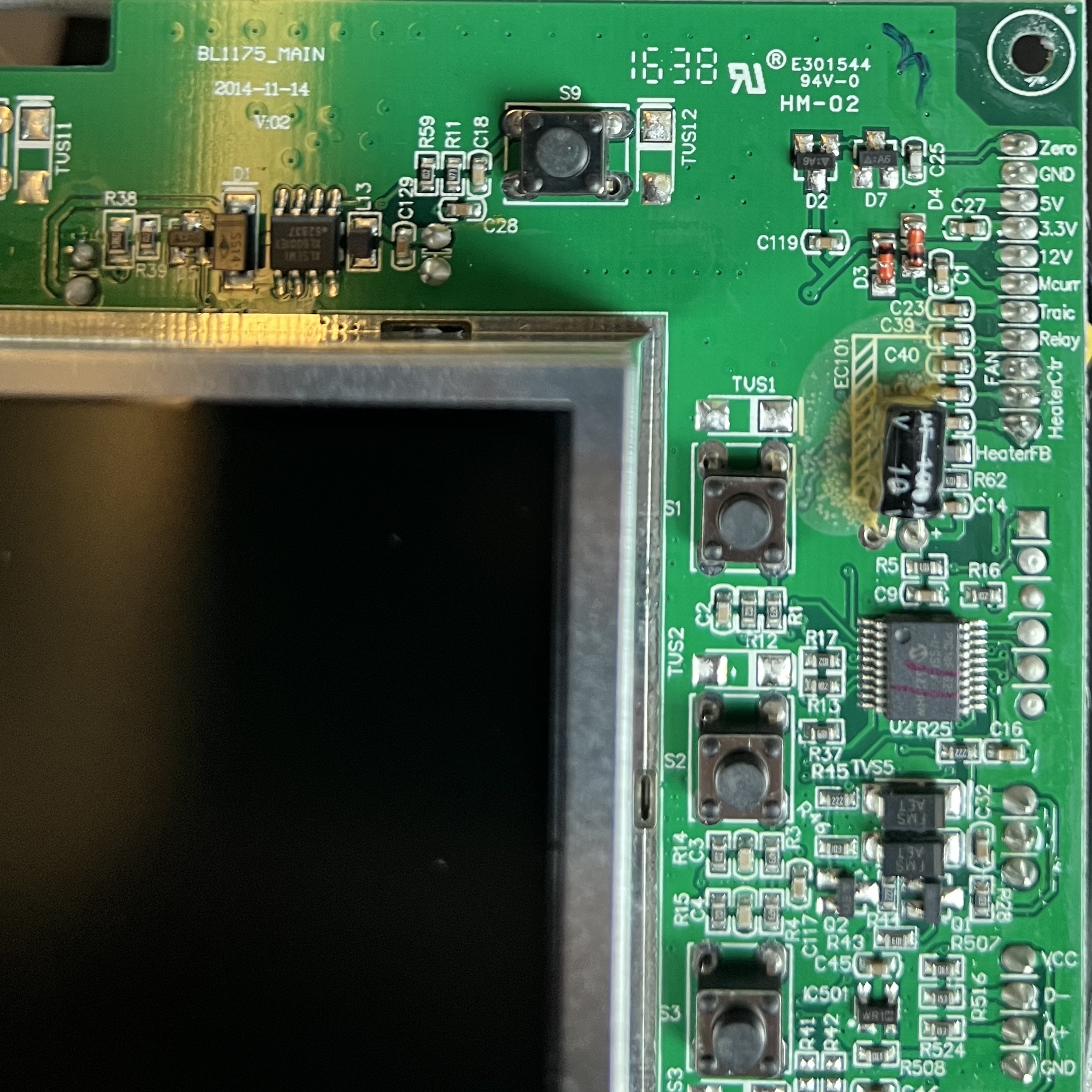These are my notes in trying to understand how the Magimix Cook Expert works software / hardware wise. Would love to understand how to control the hardware, the french version has a USB bluetooth dongle that you can insert in the USB port, I want to see if I can "upgrade" my non french version to the same bluetooth connectivity.
the firmware for the non bluetooth version, and bluetooth version are identical, so in theory, its possible?
- BL1175_MAIN
- 2014-11-14
- V:02
- 1638
- E301544
- 94V-0
- HM-02
- IC500
- RU ( Recognized Component Mark )
The "Recognized Component Mark" is a type of quality mark issued by Underwriters Laboratories. It is placed on components which are intended to be part of a UL listed product, but which cannot bear the full UL logo themselves.[6] The general public does not ordinarily come across it, as it is borne on components which make up finished products.
IC (1) XLSEMI XL6001E1 62837 ( Identified as 400KHz 32V 2A Switching Current Boost LED Constant Current Driver )
due marking, these are the options left which it can be
- PIC16F1826
- PIC16F1826T-I/SS
- PIC16F1826-I/SS
- PIC16LF1826-I/SS (I don't think its the T, since that would show on the ic)
I'm fairly certain its this one
IC (3) 6757 3S26 M-L ( does this say 3526 M-L? this could be a LM3526 Dual Port USB Power Switch and Over-Current Protection
What controls that giant display then? Is this something I overlooked? When I google the firmware filename lpc1788.bin, I come across NXP - LPC1788 microcontroller with LCD Graphics Controller, is this hidden under the display plate? (its on a big raiser)
Current best guess: the firmware lpc1788.bin is 220Kb, thats way too big for that PIC16F82 let alone drive a decent resolution display, images, icons, animations, etc... so I think the main chip is under the display (big aluminium box) and based on the firmware name " lpc1788" it might just be that one 🙄
- 32-bit ARM Cortex-M3 microcontroller; up to 512 kB flash and
- 96 kB SRAM; USB Device/Host/OTG; Ethernet; LCD; EMC
This looks like something more capable then the PIC16, and it has JTAG and stuff
Based on the PIC16LF1826-I/SS it looks like there are 2 compilers
- XC8 compiler
- HI-TECH PICC
flash.bin ( IPFS QmQbvSE9QcdJZjWrYR1725nyrUUioMi51nixRzzSp277M5 )
- MD5 ea4f67872a67aaf16435360c8c5d7a75
- SHA-1 213d984924dadfbf8a704f33e7749b171ad203fc
- SHA-256 b931c9b3506dd288e03453c1e5e66b5eb94df6b90dd15e566deaa02ea3038e43
- SSDEEP 6144:Rqz6Jn/syKVgEf4lrT5KTf5Z8PVYw2+Z+x1:RLblrl9Vc1
lpc1788.bin ( IPFS QmVY3NxQ3sMiL98QBqFQ9tcbwcr75BWPdHw7cBWAz1rLP1 )
- MD5 9f6df216e6452656ce91be420473119b
- SHA-1 14eb7f05b237c4e2133d4dd51078e01f4a4cb8df
- SHA-256 4db01a4c95e2a51debb7a7ec143a58106a5863352442fa717c908cf9331aa4ea
- SSDEEP 1536:Z4ZV6CLFrXtgbhhEJQ2o/Nj2GVSysAvbDOM1XcAI:2V1pXtghGK2Mj7Y6/OMWD
flash.bin ( IPFS QmfRuQrCgV6RjxYAPxqccaw6TaBenk3bwcGBkaFFoFpVdE )
- MD5 a5576c9f1ebde4ecaf42ae0d9cad723a
- SHA-1 caf8e7ac6a9ad957d497efedb1505747fe729acc
- SHA-256 b38fad98a4576a901df541d39ed758e32134734fca32c4d15c1f5042bb80fb4e
- SSDEEP 12288:JEOnJEhgmzaZDO06eJgVVSYm4wbSZZrok:tG7z5GgVVSYm4CWb
- TLSH T18725D614FE42E811C47552B5CCAA8FC8012AAD058E37584770FBF36E67B560BF91AF98
lpc1788.bin ( IPFS QmNsNzDbr6DtL8szfBft1goSNK2KWmq4HrkHurSsibsx7d )
- MD5 92a4b7c42ec2d8890a6c5e162dba1f48
- SHA-1 fcc721d214b6c4e379f630801109b20817b8fa07
- SHA-256 450543f9740f31126fa2caf3f2a1d4affb62cdf038c817eab9c9a75e53dfc151
- SSDEEP 3072:r6m9WLKWCJNV1CM8lmqW7QRfkj6Tcx7+/OMYfoLuU/IQBHsZHPf:mmJ1TV1CMEvW7Qci4oOMEunBkPf
- TLSH T1B924858F7749728FC818873484A6C3B0B9723C747A61C9927F916B1F9DB5280EF12679








